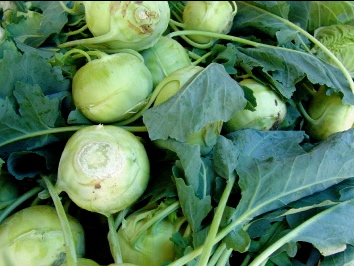
feature-image, l
(article, Megan Holden)
[%pageBreakSettings nobreak=true][%adInjectionSettings noInject=true] I just received my CSA farm’s annual letter reminding me that summer’s bounty is soon to arrive. Looking at the brochure listing the tasty veggies to come, I see my nemesis: kohlrabi. What to do with those pale, bland bulbs? And what about the year that we received three cabbages in four weeks? With an overflowing box of produce arriving every seven days and the occasional surplus glut, I devour as many vegetable cookbooks as I do veggies. In the cookbook-classics department, Deborah Madison’s Vegetarian Cooking for Everyone is my gold standard. While my family is not vegetarian, Madison provides the basics that keep me coming back: an excellent index, informative chapters, and recipes that are simple in terms of both ingredients and method. I adore her vegetable family chapters. If I want to learn more about beet tops, the greens chapter has both glossary and recipes. Such information has been crucial to my education as a CSA consumer. But there’s a bounty of vegetable cookbooks on the market. Three recent books provide new resources — and new hope — for helping with the inevitable tomato-and-zucchini bonanza. Of the three, Andrea Chesman’s The Garden-Fresh Vegetable Cookbook comes closest to Madison’s thoroughness. Chesman, a home cook and cookbook author, espouses the pleasure of eating from the places we live. Her introduction describes a well-stocked pantry, including recipes for such staples as herb vinegar and vegetable broth. In her chapter on basic recipes and methods, she educates the novice on boiling, blanching, steaming, sautéing, grilling, braising, and roasting. Chesman presents 14 master recipes that allow you to substitute vegetables at whim. Most require blanching, so that all the cooking times in the master recipe are interchangeable. A broccoli quiche, she contends, is not that different from one made with spinach. Of these, the Sautéed Vegetable Medley with Fresh Herbs and the Mixed Roasted Summer Vegetables will be workhorse recipes in my kitchen. The rest of the book is divided by season. “Spring into Summer” includes chapters on asparagus, peas, spinach, and salad greens. The three summer sections and “Fall into Winter” include most vegetable families. For every vegetable, Chesman includes growing and harvesting tips, times and quantities for cooking, stories, bits of lore, and inviting recipes. It’s a book that I’ll continue to pull from my shelf. Chef and food consultant Richard Ruben has shopped food markets all over the world to create The Farmer's Market Cookbook. The international flavors of its 100 recipes and accompanying market stories make it unique. From Korea to the Amalfi Coast, from Mexico to an Indian neighborhood in Queens, The Farmer’s Market Cookbook serves as both travel guide and cooking resource. Chapters on spring, summer, and autumn each contain sections on starters, main courses, sides, and desserts. Separate charts on spring herbs (such as sorrel, lemongrass, and lavender), summer’s chile peppers, and winter squash highlight Ruben’s emphasis on eating what’s local and ripe. Ruben includes a wide range of recipes for the home cook. Fast, family-friendly meals — such as Lamb Ragout — I will prepare again. Recipes with more esoteric ingredients, such as Poached Lobster Tails and Sautéed Fiddleheads, might show off the bounty of the market, but not the reality of my kitchen and budget. Finally, The Farmer’s Market Cookbook lacks one essential ingredient: an index. Faced with my weekly box of veggies, I must have an index. [%image feature-image float=left width=350 caption="What to do with a bucket of kohlrabi?" credit="Photo: iStockphoto/gaffera"] The Tomato Fresh Food Café in Vancouver, B.C., has been serving up “fresh, local, socially responsible food, from the farmer’s fields to the dinner table” since 1991. As Fresh As It Gets: Everyday Recipes from the Tomato Fresh Food Café gives its diners — and the rest of us — the opportunity to cook from its cherished recipes. In their introduction, authors (and café co-owners) Christian Gaudreault and Star Spilos describe walking through the Trout Lake Farmers’ Market in East Vancouver, chatting with vendors. Their conversations whet the reader’s appetite for the recipes to come. I am usually suspicious of restaurant cookbooks; the preparations are often too rich and complicated. This is not the case with As Fresh As It Gets. The breakfast/brunch chapter, for example, features such unfussy classics as Buttermilk Cornmeal Pancakes and Zucchini and Eggplant Omelet. Likewise, numerous recipes in the vegetable side-dish chapter will inspire farmers’-market aficionados and veggie gardeners alike. [[block(sidebar). h1.Featured recipes]] Come August, Summer Roasted Roma Tomatoes, Roasted Baby Fennel Bulbs, and Grilled Corn will all be on my table. Some main dishes were more complicated than I can manage even when I entertain (see Garlic Oregano Marinated Lamb Sirloin with Almond Sage Pesto and Fig Jus). But on the whole, As Fresh As It Gets will help you to eat the truly fresh and local. As for what to do with kohlrabi, none of the books have any recipes. Hm, maybe there’s a message here? Chesman offers tips for cold storage. But somehow I don’t think I’ll be bringing in a large crop and storing it through the winter. p(bio). Megan Holden reviews books from her kitchen in Portland, Oregon.

feature-image, l

reference-image, l